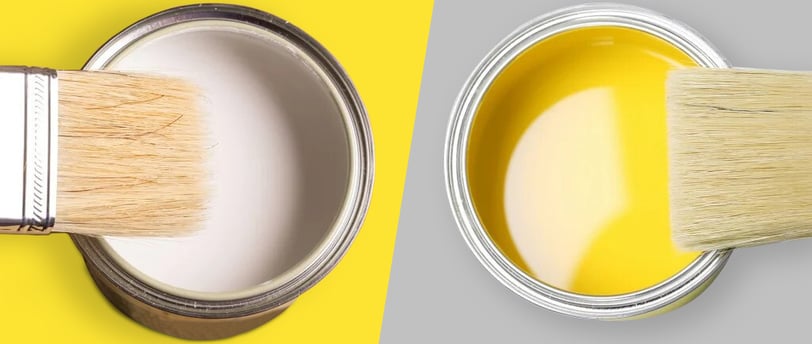Oil-Based vs. Water-Based Paint
What is the better choice, oil based paint or water based? Here we finally conclude the lifelong debate of many veteran painters.
BLOG
5/12/20257 min read


No matter how good the mechanics of your project are, they will always look bad if you do not have the proper color of paint used on it. Paint and its vibrant color are the first things a person notices. Using the right type of paint can provide your project with the look it requires to stand out. The two types of paints, Oil based and water based, each have their own strengths and weaknesses. Oil paints dry out to become a hard textured, long lasting paint and give a very glossy look. However water based paints have lower odors and less harmful fumes (VOC’s) In the following article, we will identify the key differences between the oil and water based paints so that you can choose the one that fits your project best!
What Is Oil-Based Paint?
Definition: Oil-based paint uses an organic solvent (like mineral spirits or turpentine) as its base. Pigments are suspended in oils (commonly linseed oil) and solvents that evaporate as the paint dries. Because oil-based paints use oil or chemical solvents, they are often also called oil enamel paints.
Key characteristics: Oil-based paint goes on thick and slick. It tends to have a high sheen (gloss) finish and levels out smoothly, which is why it’s popular for trim and cabinets. It dries slowly (see drying times below) and typically builds a very hard, durable film. However, oil-based paint can become brittle or yellow over time. It emits strong fumes and high levels of VOCs (volatile organic compounds) while drying.
Pros:
Very durable and hard-wearing (good for high-traffic areas).
Resists scratches, stains, and moisture better than many latex paints.
High-gloss finish that “levels” well for a smooth look.
Doesn’t fade or dull as quickly in bright light.
Cons:
High VOCs & odor: Gives off strong fumes and requires good ventilation.
Long drying time: Takes many hours to become tack-free and usually 24 hours (or more) before recoating.
Yellowing: Light colors (especially whites) may yellow with age.
Hard to clean up: Brushes and rollers need solvents (turpentine or paint thinner) for cleaning.
What Is Water-Based Paint?
Definition: Water-based paint (often called latex or acrylic paint) uses water as the primary solvent or carrier. The pigments and binders are mixed in water, which evaporates as the paint dries. (Despite the name “latex,” these paints contain no latex rubber; the term refers to the plastic-like binder.)
Key characteristics: Water-based paints are thinner and more fluid. They dry much faster (within minutes to a few hours) and release very little odor or VOCs. They usually have a lower natural sheen than oil-based paints, but modern formulations can still provide durable and attractive finishes. Water-based coatings stay more flexible once dry, so they expand and contract with temperature changes and resist cracking.
Pros:
Low VOCs & low odor: Much safer for indoor use and have minimal “paint smell”.
Quick drying: Often touch-dry in under an hour with full recoating possible in 2–4 hours. This speeds up projects.
Easy clean-up: Brushes and tools clean up with just soap and water.
No yellowing: Colors stay true over time (they won’t turn yellow the way oil paints can).
Cons:
Less durable (historically): Though improved, many water-based paints are still not as hard or stain-resistant as oil enamels.
Prone to fading: Colors may fade or wash off more easily in harsh conditions or with abrasion.
Moisture sensitivity: Prolonged wet exposure can soften some water-based finishes. Extreme cold can affect adhesion.
Key Differences Between Oil-Based and Water-Based Paint
Here are the major differences of oil and water based paints.
Drying Time: Oil paint takes a long time to dry, usually 6-8 hours to become properly dry and requires a waiting time of 24 hours for a recoating session. However water based paint requires only an hour to dry up, second coating can be easily done in 3-4 hours. The faster drying makes water based pain incredibly efficient for DIY or time sensitive projects.
Finish & Appearance: Oil-based paint usually provides a glossier, smoother finish. It resists fading and dirt, but over years it can yellow, especially on bright whites. Water-based paint tends to have a matte or satin finish by default. Its sheen doesn’t dull over time, but very glossy water-based finishes are harder to achieve without additives.
Durability: Traditionally, oil-based coatings dry into a harder film, giving them higher abrasion and stain resistance. They seal well against moisture, making them ideal for high-wear surfaces like trim and doors. Modern water-based paints have closed the gap: they still dry somewhat softer but are more flexible (expanding/contracting with climate). In general, oil-based is more chip-resistant, but new water-based formulas are quite durable for most home projects.
VOCs & Safety: Oil-based paints release volatile organic compounds (VOCs) as they dry, emitting strong, potentially harmful fumes. Prolonged exposure can irritate eyes, skin, or lungs. Many regions restrict VOC limits in paints for this reason. Water-based paints have very low VOCs, so they’re safer for indoor air quality and the environment.
Cleanup Process: Cleaning up water-based paint is easy, brushes and rollers wash out with soap and water. Oil-based paint cleanup is more involved: you must use mineral spirits, turpentine, or commercial paint thinner, and dispose of waste carefully. This extra work is a drawback when using oil-based paints.
When to Use Oil-Based Paint
Oil-based paint excels on surfaces and projects that need a hard, glossy finish and can tolerate longer drying times and fumes. Good uses include:
Trim, Doors, and Cabinets: Because oil-based enamel flows out smoothly and sands to a glass-like finish, it’s often used on baseboards, door/window trim, molding, wood cabinets and built-in furniture. The durability holds up to scrubbing and bangs.
Metal and Wood Surfaces: If you’re painting metal railings or painted wood furniture, oil-based enamels adhere and level nicely. They seal the surface well.
High-Traffic Rooms: Oil enamel on kitchen cabinets, bathroom vanities or hardwood floors will resist stains and wear. In moisture-prone areas, the water resistance of oil-based finishes can be an advantage.
Oil-based paints work best where durability and smooth finish matter more than quick drying. Be ready to paint in a well-ventilated area and allow extra dry time. You’ll also need to clean tools with solvents.
When to Use Water-Based Paint
Water-based (latex or acrylic) paint is a great all-rounder for most home projects, especially when ease and safety are priorities. Consider it for:
Walls and Ceilings: Standard interior drywall and plaster are commonly painted with water-based latex. It dries fast (less waiting time), has minimal odor (good for kids’ rooms or occupied homes), and cleans up easily if you get paint on yourself or tools.
Exteriors: Because water-based paints flex and resist UV damage, they’re often recommended for siding, trim, or outdoor furniture. They won’t crack or peel as easily in the sun and changing temperatures.
Schools, Offices, and Homes: Public buildings often insist on low-VOC latex paints for air quality. For any indoor space where ventilation is limited, water-based is safer.
Quick Projects & Novices: If you’re DIY-ing in one weekend or new to painting, latex paint is forgiving. Mistakes wipe up while wet, and brushes are easy to clean.
In short, use water-based paint when you want faster work, low fumes, and easy cleanup. It may not shine as much as oil paint on wood trim, but modern water-based semi-glosses give nice sheen too.
How to Choose the Right Paint for Your Project
To decide between oil-based vs. water-based paint, consider these quick factors and steps:
Project Location (Indoor vs. Outdoor): For interior walls and ceilings, water-based (latex) paint is usually best, it dries fast and is less toxic. Outdoors or in bathrooms/kitchens, water based exterior or semi gloss latex is common because it resists weather and mold.
Surface Type:
Wood trim, doors, cabinets: Oil-based enamel has traditionally been used for a hard glossy finish. Today, many use high-gloss acrylic latex instead, but oil is still an option if flexibility (expansion) isn’t crucial.
Metal or heavily soiled surfaces: If painting metal or needing a tough stain-blocking coat, consider oil-based primer/paint.
Drywall, plaster, masonry: Go with water-based interior wall paint (latex).
Desired Finish: Oil paints give the highest gloss and smoothest flow. If you want a really shiny, enamel look, oil-based (or an alkaline-based enamel) is the choice.
Dry Time and Workflow: If time is tight or you want multiple coats in one day, pick water-based for its quick drying. If you’re patient and doing one coat at a time, oil-based is fine.
Ventilation and Health: Working in a small or poorly-ventilated space? Latex (water-based) is safer because of low fumes. Oil-based projects should be done with windows open or outdoors.
Cleanup Convenience: Water-based paint cleans with soap and water, an advantage for beginners and convenience. Cleaning up oil-based paint means handling harsh solvents (and disposing of them properly).
Experience Level: Beginners often find latex paint easier to work with (and less finicky about technique). Oil-based paints are stickier and take longer to master for an even coat.
Use this checklist to weigh your needs. For example, if you’re repainting bathroom cabinets, durability might win (oil or special satin acrylic), but for a bedroom wall, latex is usually the clear winner.
Conclusion
There is no definite winner in this oil-based vs. water-based showdown! Oil paints provide more hardness and gloss. On the other hand, they dry slowly and have a strong odor! Water-based paints dry fast, less strong odor, and come a long way with performance-wise, mostly good for walls and exteriors. So the main thing to take home: choose the paint depending on what your project needs; make considerations for surface, environment, and your workflow.
Need a professional touch? Explore our Painting Services and let’s bring your project to life with the perfect finish!
FAQs
Is oil-based paint more durable than water-based paint?
Generally, yes. Oil-based paint dries into a harder, more wear-resistant film than traditional latex. It resists scuffs, stains, and moisture better. However, modern high-quality acrylic paints are quite durable too. In high-traffic or moisture-prone areas (like trim and cabinets), oil-based is often chosen for its durability.
Can you paint water-based paint over oil-based paint?
Yes – but preparation is crucial. You must sand or scuff the old oil finish to remove its glossy sheen, then apply a good bonding primer before using latex paint. Without this prep, the new paint may not stick.
Which paint is easier to clean up?
Water-based paint is much easier to clean up. You can simply wash brushes, rollers, and spills with soap and water.
Is oil-based paint banned in some areas?
Many regions have strict regulations on high-VOC oil-based paints. In some U.S. states (like California) and in the EU, older oil enamels have been phased out or require special low-VOC formulations. New oil paints must meet VOC limits. While oil-based paints are not universally “banned,” their sale and use are limited due to environmental laws.
Need help choosing the right paint for yourself? contact us for expert tips!
Contact
(503) 868-1211
© 2025 | Stylish Painting LLC - All rights reserved


